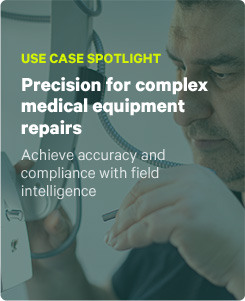At a glance:
- Visibility gaps hamper field service: Field service lacks visibility into inventory and job requirements, hindering first-visit problem resolution.
- Impact on customers and technicians: Technicians often face delays, misdiagnosis, and customer frustration, resulting in repeat visits and reduced satisfaction.
- Tech as the solution: Data-driven tools improve inventory management, streamline access to information, and enhance communication to boost first-time fix rates.
Below-average first-time fix rates are a symptom of a larger visibility problem
A First-Time Fix Rate (FTFR) is more than a dashboard metric in field service. It’s a key performance indicator that reflects customer trust and service efficiency.
Enter Bill, a seasoned technician whose experiences illustrate the realities of increasing this critical measurement. He works for a company with an FTFR of 63%, and his daily routine involves navigating a complex web of disjointed data. The critical service information he needs is frequently siloed, making it difficult to access and use effectively. On top of his primary duties, his job includes a daily quest to synchronize scattered data across his organization.
Navigating the maze: the real-world challenges of field service
As Bill begins his day, the hurdles appear almost immediately. Each one not only affects his performance but also impacts his customers and the organization:
- Ineffective inventory management: Bill arriving at a client site without the necessary parts impacts his efficiency, resulting in prolonged equipment downtime. This reflects poorly on his company and increases operational costs on return visits.
- Limited access to service history: Incomplete asset history during service calls results in extended diagnostic times, inaccurate fixes, repeated disruptions, lower customer satisfaction, and potential loss of business.
- Communication breakdowns: Miscommunications between Bill, the back office, and clients cause inaccurate work, unnecessary delays, and unmet expectations.
- Diagnostic difficulties: Bill’s work is often impacted by incomplete or incorrect assessments, leading to more visits, downtime, and customer service disruptions. These inefficiencies incur the business significant financial and reputational costs.
The average FTFR for field service businesses currently sits at 77%. This means that, on average, three of every four service calls are completed on the first visit. However, best-in-class companies set the bar even higher, often achieving rates of 88% and only needing additional visits 12% of the time. This disparity isn’t just a matter of numbers – it provides a window into an organization’s operational efficiency. Furthermore, studies show that companies surpassing the 70% threshold boast a customer retention rate of 86%, highlighting FTFR’s tangible and far-reaching impact on other important business metrics.
Here, Bill’s impact extends well beyond the scope of standard service calls. While he’s not performing the data analysis himself, the reality of his company’s FTFR casts a shadow over every task he completes. Each service call he goes on without the necessary tools, parts, or information is a go-back waiting to happen. For him, every hurdle is a signal pointing towards a critical need for higher operational visibility.
The role of technology in addressing field service challenges
Bill’s organization understands that they must improve their FTFR to remain competitive. To achieve this, they look to industry leaders for guidance. They discover that top-performing field service operations (FSOs) are leveraging the power of data – delivered to service technicians in the field and across the organization – to maintain their lead.
- Optimizing inventory management and service performance: Advanced tools and software enable more effective inventory management. They ensure technicians have the necessary parts for each service call, increasing their efficiency and dramatically reducing the need for return visits.
- Effective training and proper technician assignment: Advanced software for employee training expedites the learning curve, allowing him to train his newer colleagues with the skills needed to fix problems on the first visit. Aligning technician proficiencies and job skill requirements also ensures that field teams are fully equipped for the job at hand.
- Access to information and resources: Giving Bill immediate access to necessary information and resources during client visits is pivotal. This includes direct access to technical manuals and inventory information on essential spare parts to eliminate site surprises and prevent return visits.
Harnessing technology to improve FTFR
Bill’s journey significantly turns as his company introduces these new solutions. As his team adopts new tools and methods, they see significant operational improvements, with the potential to completely transform how they perform field service.
- Enhanced productivity: Bill shows a notable increase in productivity and job satisfaction. The new tools streamline his workflows, enabling him to complete jobs more efficiently and stay compliant, reflecting his company’s commitment to smarter, not harder, work.
- Improved visibility and predictability: With access to better data and predictive tools, he gains insights to anticipate and address potential issues before they materialize.
- Embracing digital change: Bill’s work life drastically improves as his company integrates digital solutions to help him perform his job more efficiently and better serve his clients. His remarkable performance indicators reflect these changes: faster response times, improved first time fix rates, and increased customer satisfaction scores. As others follow his lead, the organization writes a new chapter in its customer relationships, with Bill as an example of what is possible.
Conclusion
Bill’s story underscores the role of technology and the power of integrated data in improving FTFR. In his case, solutions similar to those in TrueContext’s global elevator project can significantly improve inventory management, leading to enhanced preparedness and reduced equipment downtime. Additionally, streamlined mobile workflows make the process as straightforward as possible while tackling multiple streams of work, thereby boosting operational efficiency.
Want greater field efficiency and customer satisfaction metrics? Contact our sales team for a conversation on improving your FTFR.




